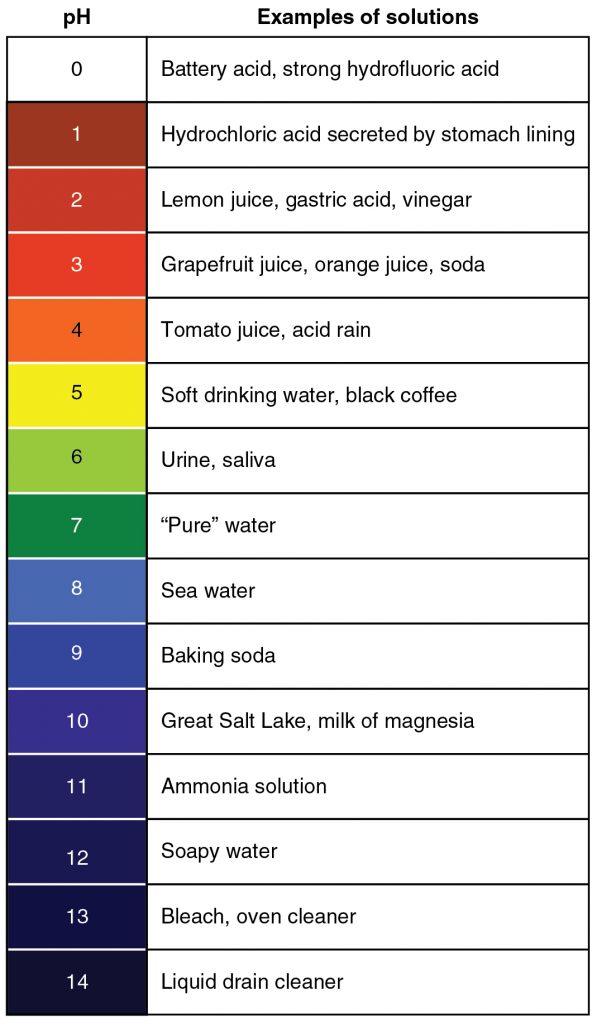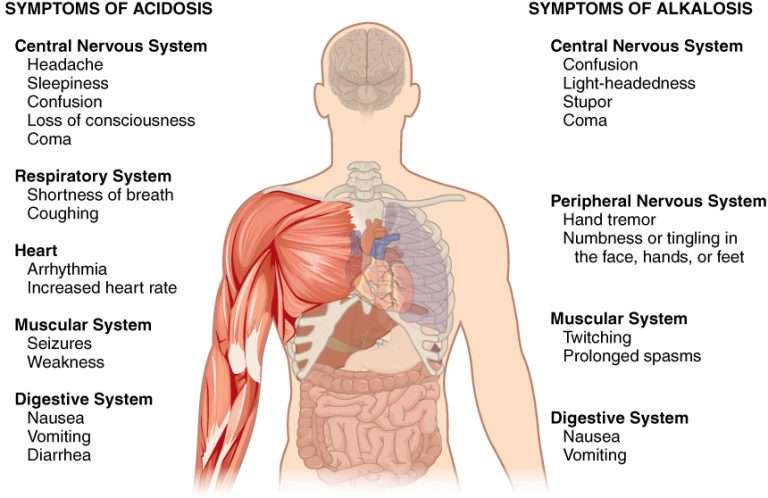Important lab values
- pH
- Normal/neutral = 7.35–7.45
- Below 7.35 = acidic
- Above 7.45 = alkaline

-
Partial pressure of oxygen (PaO2)
- Normal = 75–100 mmHg
- Below 75 = hypoxemia
- Above 100 = hyperventilation
-
Partial pressure of carbon dioxide (PaCO2) – related to respiratory conditions
- Normal = 35–45 mmHg
- Below 35 = alkaline
- Above 45 = acidic
-
Bicarbonate (HCO3−) – related to metabolic conditions
- Normal = 22–26 mEq/L
- Below 22 = acidic
- Above 26 = alkaline
Acid-base diseases
-
Respiratory acidosis
- Related diagnosis: COPD, pneumonia, atelectasis, anesthesia, drug overdose
- Define: the lung does not efficiently remove carbon dioxide from the system, causing a buildup of carbon dioxide in the bloodstream
- Lab values:
- pH below 7.35
- PaCO2 above 45
- Symptoms: hypoventilation, hypoxia, rapid-shallow breaths, decreased blood pressure, dyspnea, hyperkalemia, muscle weakness
-
Respiratory alkalosis
- Related diagnosis: anxiety attacks, pulmonary embolism, mechanical ventilation
- Define: the lung excessively removes carbon dioxide from the system, leading to decreased amounts of carbon dioxide in bloodstream
- Lab values:
- pH above 7.45
- PaCO2 below 35
- Symptoms: hyperventilation, tachycardia, hypokalemia, numbness/tingling of extremities, deep-rapid breathing, seizures, nausea, vomiting, light headedness, lethargy, confusion
-
Metabolic acidosis
- Related diagnosis: diabetic ketoacidosis, severe diarrhea, renal failure, sepsis (systemic shock)
- Define: excessive fluid accumulation in the body leading to a buildup of acids and a reduction in bicarbonate in the bloodstream
- Lab values:
- pH below 7.35
- HCO3− below 22
- Symptoms: headache, decreased blood pressure, hyperkalemia, muscle twitching, nausea, vomiting, diarrhea, changes in consciousness, Kussmaul respirations (compensatory hyperventilation)
-
Metabolic alkalosis
- Related diagnosis: severe vomiting, excessive diuretic use, excessive antacid use, excessive gastrointestinal suctioning
- Define: the body has removed too much acid or retained too much bicarbonate, leading to an alkaline shift in the bloodstream
- Lab values:
- pH above 7.45
- HCO3− above 26
- Symptoms: restlessness, tachycardia, compensatory hypoventilation, confusion, nausea, vomiting, tremors, cramps

Symptoms of acidosis/alkalosis
Treatment of arterial blood gas disorders
There are three types of compensation:
| Type |
pH status |
Compensation present? |
| Uncompensated |
Abnormal |
No compensation |
| Partially compensated |
Abnormal |
Compensation is occurring |
| Fully compensated |
Normal (7.35–7.45) |
Compensation has corrected the pH |
Partially compensated arterial blood gases
Definition:
- pH is still outside the normal range, so the imbalance is not fully corrected.
- The opposing system has begun to respond, but not enough to normalize pH.
Example: partially compensated respiratory acidosis
| Value |
Result |
Interpretation |
| pH |
7.30 |
Acidotic |
| PaCO2 |
55 mmHg |
High (respiratory acidosis) |
| HCO3− |
29 mEq/L |
High (kidneys compensating) |
Interpretation: Respiratory acidosis with partial metabolic compensation.
Fully compensated arterial blood gases
Definition:
- The pH is back within normal range (7.35–7.45) due to effective compensation.
- One component remains abnormal, indicating that a primary disorder still exists, but the body has corrected the pH.
Example: fully compensated metabolic acidosis
| Value |
Result |
Interpretation |
| pH |
7.36 |
Normal (low end) |
| PaCO2 |
30 mmHg |
Low (lungs compensating) |
| HCO3− |
18 mEq/L |
Low (metabolic acidosis) |
Interpretation: Fully compensated metabolic acidosis.

